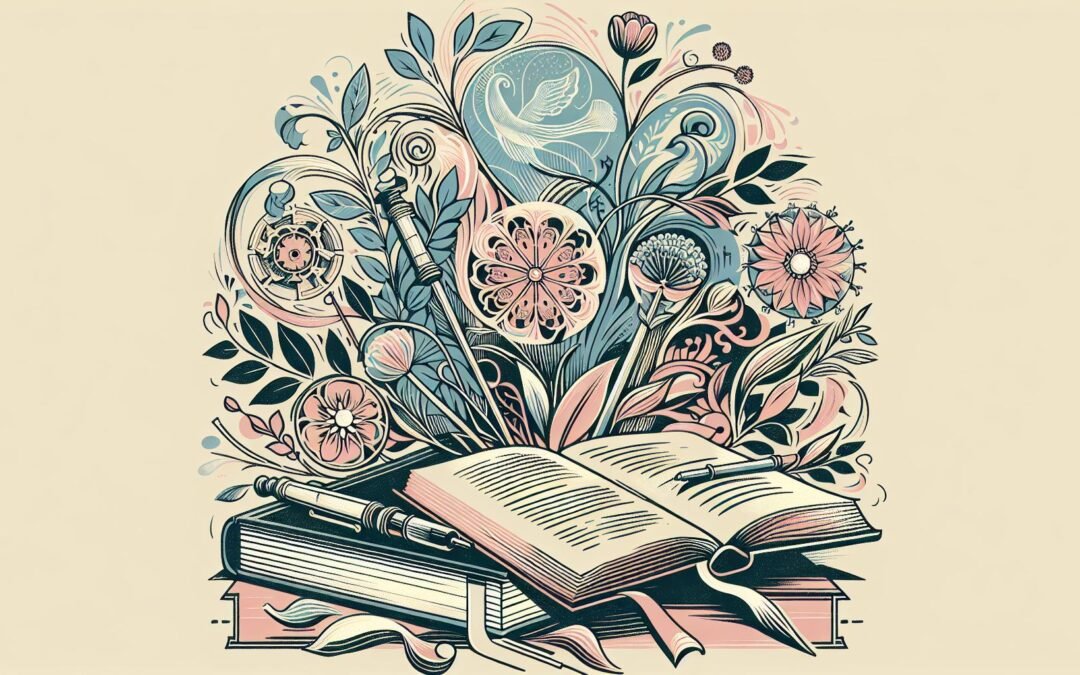Rhyming poetry embodies the spiritual music of language, a stream shaped by the divine pull of sound’s embrace. Rhyme is the soul’s echo, a sign that meaning wishes to leap beyond boundaries. Through rhyme, the spoken tapestry gathers energy and memory, harnessing repetition for remembrance and delight. The interplay between rhyme, rhythm, and theme weaves the poet’s craft into a revelatory garment, inviting reader and listener alike to step into the circle of tradition and renewal. In this temple, every echoed syllable traces desire, invocation, and the eternal longing for unity that love and verse share. Many who are drawn to explore rhyming poetry about love sense this gentle magnetism: rhyme bewitches and unites hearts across time as do ritual, song, and prayer.
The Tradition and Origins of Rhyming Poetry
The roots of rhyme spring from oral poetry’s devotion to memory and enchantment. Among the earliest civilizations, Sumerian hymns may reveal repeating sounds that ripple through ritual, although elaborate terminal rhyme belongs elsewhere. The epic poetry of Greece and Rome spins its patterns through meter and repeated sound, but formal end rhyme does not dominate their river of verse; instead, the pattern deepens in new soil. Tang Dynasty poets in China intertwine rhythm, tonal music, and rhyme to create a harmony unique to their language’s spirit, setting verses afloat in ceremony and scholarly conversation.
In the world of Arabic and Persian poetry, rhyme attains an exalted status: the ghazal and qasida lift repeated final syllables as lanterns for longing, allowing each poem’s refrain to glow with mystical resonance. Later, Persian innovators refine these forms, cultivating schemes that cross to Turkish and Urdu, carrying new fragrances and musical possibilities as they flower further east. Throughout these journeys, rhyme is not static but changes shape, molding itself to each phonetic ecosystem. Its forms remain living creatures, never fossils. When English poetry shifts from the alliterative power of Beowulf to the rhymed couplets of Chaucer, the transformation occurs not in pure imitation but in the movement of souls—Norman French, liturgical Latin, and the sounds of love all mingling. Poets from every tradition carry rhyme forward, bearing testament to shared longing inside the abodes of language. For seekers of ghazal or English lyric, these migrations of rhyme mirror the migrations of the heart.
The Evolving Spirituality and Craft of Rhyme
Rhyme migrates on many wings: sometimes it acts as a constraint, sometimes as pure grace. The troubadours of Southern France fill their verses with rhyme to reach ecstatic states, and their influence ripples across the map of Europe. In Dante’s Divine Comedy, rhyme climbs the arduous spiral of the terza rima. Petrarch and Shakespeare channel intricate emotional turns into sonnets, each structured by rhyme’s invisible geometry. Villanelles, odes, and ballads—each form devotes itself to recurring sounds as if tending a secret fire. In oral traditions of West Africa, some griots sow seeds of rhyme to anchor memory, yet many more seek rhythm, repetition, and melody for the weaving of their tales. The music of rhyme serves less as rule than as instrument of revelation: a means to awaken the sacred in common language.
With the arrival of modern poets, rhyme ceases to be a demand and instead becomes the lover’s call: sometimes met, sometimes refused, sometimes echoing in ghostly forms. Rhyme masters like John Keats or Pablo Neruda tie spirit to syllable, making each echo a step toward transcendence. Modern and contemporary poets create mosaics of sound, testing the boundaries of full, slant, and internal rhyme as though casting pebbles on moving water. For many, the magic of love poetry still calls forth rhyme as the true herald of feeling.
Types of Rhyme
The varieties of rhyme reveal poetry’s infinite avenues, as rivers branch through dry stone or flowering meadow. These forms contain histories as vivid as those of kingdoms, each with its blessings and mysteries, each awakening a particular aspect of the listener’s soul.
End Rhyme
End rhyme gathers sound at the terminus of lines, crystallizing the closure or opening of thought. In Shakespeare’s sonnets, pairs such as “May” and “day” spin an axis for argument, infusing the poem with symmetry and finality. This type of rhyme inscribes the border between lines and marks the progress of theme and emotion. Lovers who read rhyming poems discover in end rhyme the architecture of promise, regret, or hope, much as Rumi brings each line to a point of spiritual arrival.
Internal Rhyme
Internal rhyme suspends pattern within lines, letting echoes bloom as if from a secret orchard. Edgar Allan Poe’s “Once upon a midnight dreary, while I pondered, weak and weary” enlivens the interior world of the line, creating resonance that pulses through the entire poem. Here, rhyme becomes a form of meditation, awakening paired meanings from within a single breath. Internal rhyme is beloved by artists seeking the living presence of language, visible in hip-hop’s intricate patterning and in the chanting of sages.
Slant Rhyme
Slant rhyme offers the shadow of unity, paralleling true harmony yet sustaining a fruitful difference. Emily Dickinson’s pairings, such as “soul” and “all,” create a bardo where certainty shimmers yet dissolves, inviting readers to taste the mystical hesitation between correspondence and dissonance. Slant rhyme is a path for those who crave uncertainty and beauty’s imperfect bloom. In Emily Dickinson’s poetry, slant rhyme supports the interplay of clarity and mystery as moonlit water supports reflection and ripple.
Eye Rhyme
Eye rhyme exists where the visual forms of words suggest kinship, but the tongue discerns otherwise. Pairs like “love” and “move” summon expectation, only to dissolve them in the alchemy of voice. Eye rhyme dances at the threshold between what is read and what is heard, playing with the deep tension between the eye’s promise and the ear’s revelation. Poets harness eye rhyme to illuminate the distance between surface and truth, thereby honoring the paradox at the heart of every real encounter.
Identical Rhyme
Identical rhyme strikes a mirror to sound, allowing whole words and meanings to reflect each other completely. In the refrain of “rose is a rose is a rose,” repetition makes sacred that which returns. Identical rhyme invokes the circularity of mantras or prayers, yielding a trance in which words are liberated through echoing self-encounter.
Masculine and Feminine Rhymes
Masculine rhyme closes with emphatic, single-syllable matches. “Stand” and “land” demonstrate finality, drawing lines of certainty, while feminine rhyme lingers and extends, binding lines through matched unstressed syllables or multisyllabic ripples: “pleasure” and “measure,” “weathering” and “feathering.” In both cases, rhyme guides the soul’s rhythm, sometimes abrupt as a bell, sometimes gentle as the hush that follows. In Elizabeth Jennings’s “One Flesh,” feminine rhymes suggest a longing for closeness or the mystery of distance inside intimacy.
Rich and Mosaic Rhyme
Rich rhyme gathers not only vowels but consonants in perfect communion, uniting words such as “raise” and “rays”—the very breath and resonance overlapping, creating puns that draw hidden meanings into play. Mosaic rhyme unfastens division: phrases like “television” with “tell a vision” bring together small units and forge unlikely links. In romantic poems that break expected boundaries, mosaic rhyme reinvigorates the art of surprise.
Rhyme Schemes and Formal Structures
Rhyme schemes are the scaffolding from which imagination builds its palaces. Clarity and pattern bloom together, yet the possibilities remain endless. Through regularity and innovation, poetry channels repetition into revelation, yielding form without tyranny and surprise without chaos.
Traditional Rhyme Schemes
Simple couplets bind two lines by rhyme, forming a pattern as consistent as lovers walking side by side. The ABAB structure, or alternate rhyme, causes anticipation to dance ahead, promising return without mechanical repetition. Enclosed rhyme (ABBA) enfolds language inward, presenting a moment of shelter within a stanza’s embrace. Sonnets spun by Petrarch and Shakespeare arrange argument, longing, or resolution along a preordained path. The villanelle, with its swirling repeats (ABA across nineteen lines), and the sestina, arranging lexical repetition across six stanzas, both enact cycles of movement and recurrence. Poems of love, like the sonnet, transform structure into ritual, channeling feeling toward catharsis. Readers wishing to learn more about sonnet forms discover these schemes as blueprints for both discipline and discovery.
Rhyme in Free Verse
Free verse welcomes freedom, relinquishing obligatory rhyme but not abandoning musicality. Some poets allow subtle internal rhymes or slant rhymes to appear like sudden birds entering a still garden, creating surprise or delight. The absence of obvious rhyme awakens the ear to accidental harmonics and gives presence to each word’s individual sonority. When rhyme emerges unexpectedly in free verse, its effect magnifies: a hinge in the middle of a thought or a subtle echo that points to hidden unity. Contemporary love poetry engages this inheritance, balancing tradition and innovation without fear of contradiction.
Canonical Examples and the Living Future of Rhyme
Classic works chart rhyme’s journey. In Wordsworth’s “Tintern Abbey” end rhyme anchors memory, much as the river carries prayer through valleys of loss and hope. Chaucer’s “Canterbury Tales” celebrates the rhymed couplet, herding pilgrims’ stories as sheep are called from pasture at dusk. Dickinson’s slant rhyme disrupts expectation even as it invites vision; Eliot’s subtle patterns in “The Waste Land” layer rhyme like colors within stained glass. Every tradition claims its icons: Persian ghazals, Chinese regulated verse, and the spontaneous compositions of modern performance poets shape rhyme into living form. In American hip-hop, complex mosaics of rhyme become vehicles for storytelling, resistance, and self-invention. Online, millions still compose good morning poems for her using rhyme as an offering of presence and care. Each poem, ancient or new, is a garden where the water of rhyme nurtures the flowering of soul and sound, revealing that love, language, and music are never separate.

